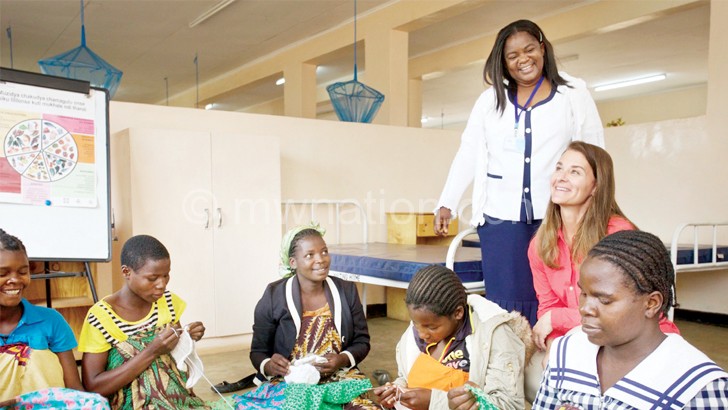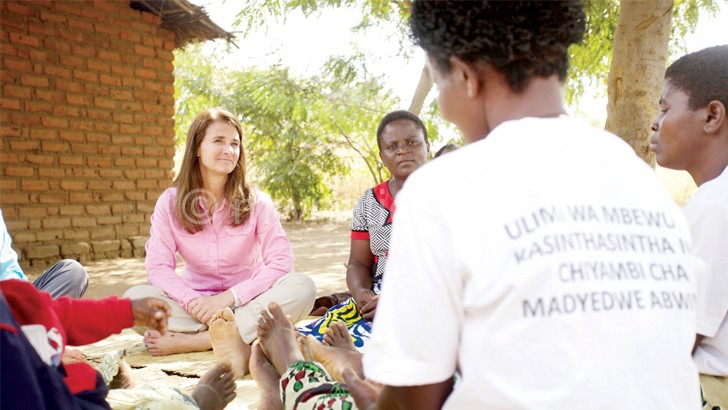Gates’ three steps toward achieving Malawi’s promise
Melinda Gates and her husband Bill Gates, co-founder of Microsoft, started the Bill & Melinda Gates Foundation in 2000. As the world’s largest philanthropic organisation, it focuses on global health and development in Africa and South Asia. Melinda’s particular areas of focus are women and girls, gender equity, and child health. In mid-June, she visited several sites in Malawi and spent two nights at the home of a family of smallholder farmers and now writes about her Malawi experience.

When I was in Malawi last month, I met a young woman named Sala, who is expecting her first child. Like so many parents all over the world, Sala wants to give her child opportunities she herself never had.
Sala was born 19 years ago at home in her parents’ village. But she knows that pregnancy and delivery are dangerous times for both mothers and babies and that, when a woman delivers outside a health facility, the risks to both her and her child go up even higher.

That is why, last month, Sala journeyed five hours—by bus and by foot—to a new maternity waiting home in Lilongwe where she will stay until she gives birth. There, she can be sure that when she goes into labour, she will be only a few steps away from a health facility—and that her newborn will have the best possible start in this world.
The journey Sala took to Lilongwe is part of a bigger, broader march toward progress in Malawi. All across the country, Malawians determined to create a brighter future for their children are making not only small steps—but enormous strides—toward a healthier, more prosperous life for themselves, their family, and their country.
Already, you can see the results of their efforts. There is no greater example of Malawi’s commitment to its future than the fact that more children born in Malawi are living to see their fifth birthdays than ever before. Thanks to the incredible partnership and political will that enabled the widespread adoption of cost-effective and proven solutions like vaccinations and insecticide-treated mosquito nets, Malawi is one of the only countries in sub-Saharan Africa on track to meet the world’s goal of reducing child mortality by two thirds by 2015. This is a stunning achievement for Malawi and irrefutable proof that progress is possible.
But still, challenges remain. Pregnancy and delivery continue to be a difficult and dangerous time for many Malawian women and babies, and millions of Malawians—especially smallholder farmers—still live under the crushing burden of extreme poverty. I saw this firsthand during the two nights I spent at the home of a very gracious family of smallholder farmers about an hour outside Lilongwe.
All of the Malawians I met tell me that they are ready to push the country’s progress even further. They say that, next on the agenda, those who care about creating a better Malawi must invest in three key areas crucial to the country’s future: saving the lives of newborns, improving health outcomes for women during pregnancy and delivery, and unlocking the potential of smallholder famers.
Saving newborn lives
Even with Malawi’s success in reducing child mortality overall, these gains have not yet fully extended to newborns. Every year, more than 14,000 Malawian newborns die during their first month. To address this, Malawi will launch its Every Newborn Action Plan in July.
This effort will scale-up simple, proven interventions such as breast-feeding immediately and exclusively; keeping umbilical cord cuts clean and dry to prevent infection; and skin-to-skin contact with their mothers to keep their body temperatures regulated. Solutions like these have already saved the lives of hundreds of thousands of newborns worldwide. This is our opportunity to expand them to the next generation of Malawians.
Improving maternal health
Today, Malawi’s maternal death rate is one of the highest in the world. These losses are all the more heartbreaking because so many of them could have been prevented.
To save women’s lives, Malawi is enacting groundbreaking programs like the Safe Motherhood Initiative, which our foundation is proud to support. This initiative is bringing high-quality, lifesaving care to more women by increasing the number of community midwives and encouraging more women to deliver in health facilities. This effort will also expand the availability of maternity waiting homes like the one where I met Sala. Maternity waiting homes ensure that, when it counts the most, both mothers and their babies are in reach of the help they need.
Increasing women’s access to family planning information, services and contraceptives is another key part of the equation—and one that is important to me personally as a staunch advocate for women and girls. We know that when women can time and space their pregnancies, it improves the health and wellbeing of both women and their families.
We also know that death and complication rates are especially high for adolescent girls who give birth before their bodies are ready. Earlier this year, Malawi took an important stand for these young mothers when President Peter Mutharika approved a new law raising the legal marriage age from sixteen to eighteen. In addition to keeping girls in school longer and improving their economic prospects, this law will also save lives by helping adolescent girls delay their first pregnancy.
Investing in smallholder farmers
But making sure that more mothers and babies survive is just the beginning.
There is no path to prosperity for Malawi without unlocking the potential of the agricultural sector. Agriculture employs more than 85 percent of Malawi’s rural population and accounts for more than a third of its gross domestic product. Yet, despite the sector’s importance to the country’s economy, it is far from achieving its potential.
One key reason the sector continually underperforms is that women farmers face many gender-specific barriers that limit their productivity. Crops that are considered “women’s crops”—like groundnuts and soya—generally receive less research and development than crops that are traditionally considered “men’s crops,” like tobacco and maize. Women also have less say in their household finances, less decision-making power over farm-related decisions, and more household tasks—like cooking, and childcare that take them away from their fields.
Fortunately, Malawi is already exploring ways to dismantle the barriers women farmers face. In the Kasungu District, I met smallholder farmers who are part of the Farmer Field and Business Schools run by an organisation called Care Pathways, which takes an integrated approach to empowering women farmers.
At farmer field and business schools, both men and women farmers can learn about better techniques and technologies that can help improve their yields, from connecting farmers to better seeds all the way to improving their market access. What I love about this programme, and what makes it so effective, is that it doesn’t focus on agriculture alone. It also addresses other issues affecting farmers’ lives—from improving nutrition to helping shift gender norms so that women farmers have more of a voice both inside their homes and beyond.
From the highest levels of government to the smallest farm plots in the most rural villages, the Malawians I met are committed to building a better Malawi for the next generation.
By matching their determination with our own—and continuing to invest in proven interventions for Malawi’s children, mothers, and farmers—we can push Malawi even closer to its promise.





